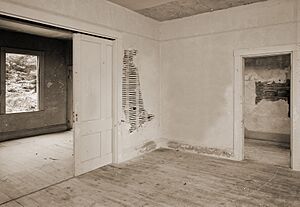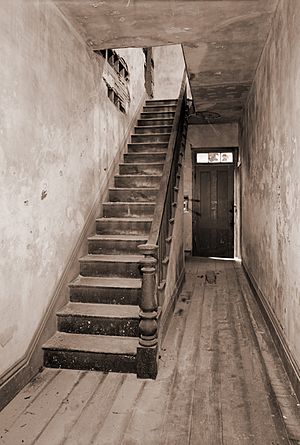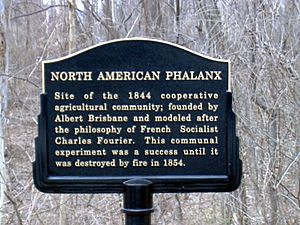North American Phalanx facts for kids
|
North American Phalanx
|
|
|
Formerly listed on the U.S. National Register of Historic Places
|
|

One of two primary residential edifices of the North American Phalanx as it appeared in August 1972, shortly before its destruction by fire
|
|
| Location | Phalanx Rd. |
|---|---|
| NRHP reference No. | 72001499 |
Quick facts for kids Significant dates |
|
| Added to NRHP | 1972 |
| Removed from NRHP | 1974 |
The North American Phalanx was a special kind of community in Colts Neck Township, New Jersey. It was a "utopian socialist commune," which means people lived and worked together, sharing everything. They hoped to create a perfect society.
This community was one of the longest-lasting of about 30 similar groups in the United States. These groups were inspired by the ideas of a French thinker named Charles Fourier. The North American Phalanx started in September 1843. It included famous people like writer Albert Brisbane and newspaper publisher Horace Greeley.
The community ended in January 1856 after a big fire. This fire destroyed many of the buildings where they worked. At that time, it was the last of the Fourierist communities still active. The main living building of the phalanx was a three-story wooden structure. It stood empty until it was also destroyed by fire in November 1972.
Contents
How the North American Phalanx Started
The Big Idea: Fourierism
Charles Fourier (1772–1837) was a French thinker. He believed that modern life caused problems like poverty and unhappiness. He thought people would be happier living in organized communities. He called these communities "phalanstères." In these places, about 1,620 people would live and work together.
Fourier's ideas became popular in the United States in the 1840s. This was thanks to Albert Brisbane. He wrote books and newspaper articles, especially in Horace Greeley's New York Tribune. Brisbane helped Americans understand Fourier's ideas. This led to many local groups, called "phalanxes," being formed.
Planning the Community
In early 1843, Brisbane and Greeley asked people in New York City to form Fourierist groups. This led to a group called the Albany Branch of the North American Phalanx. About 20 families planned the group, and 12 families officially joined in August 1843.
The first members hoped to raise a lot of money. They also thought many other groups would start in New York. But these hopes did not come true. They only raised about $7,000. Most of the money came from outside the community. About 61% of the community's shares were owned by people who didn't live there.
Even with limited money, the Albany Branch decided to continue. Charles Sears and Nathan Starks led the group. They started looking for land to build their community.
Building a New Home
They found a large piece of land, about 673 acres, near Red Bank, New Jersey. It cost $14,000. They used $5,000 as a down payment. This left a $9,000 mortgage to pay later. They had only about $2,000 left for buildings, animals, and tools.
People started moving in during September 1843. Six families lived in two existing houses. They quickly built temporary homes for others for the winter. More people arrived in the spring of 1844. By the end of that year, 100 people from 20 families lived there. At its busiest, the community had about 150 people, including children.
After one year, they had built a saw-mill and a blacksmith shop. A machine shop powered by a steam engine was also working. The community also had stables, sheds for animals and wagons, and carpentry shops. There was a school and a day care for children. They also had guest cottages, gardens, paths, and a pond for swimming and ice in winter.
Most of the adults knew about farming. The land was good for growing fruit. They planted many fruit trees like apples, peaches, pears, and quince. They also planted grape vines.
In 1847, they built a new three-story addition. This added more common space. Each family then had a living room and two bedrooms. A large restaurant, 70 feet long, was also built.
The North American Phalanx did quite well for its first seven years. It paid back 4.4% to 5.6% each year on the money invested. Workers also earned hourly wages.
Life in the Community
Work and Pay
In the Fourierist system, work was divided into main areas called "series." The North American Phalanx had six series: farming, animal care, making things, housework, education, and entertainment. Each series had smaller groups of 3 to 7 people. These groups worked together on specific tasks. For example, the farming series had groups for general farming, market gardening, orchards, and experiments.
Each group chose a leader. This leader kept track of work hours and attended meetings with other group leaders. These leaders then chose a main manager for their department. All the main managers met daily to decide what jobs needed to be done the next day.
Women did the housework, which was also organized into groups.
At the end of each year, they calculated how much the community had produced. Then, they paid people based on their investment, work, and skills. For example, people earned 5% on their invested money. They also earned $1 for a ten-hour day of "ordinary" work. Jobs that were hard or unpleasant paid more. Easy or attractive jobs paid less. Bonuses were given for excellent work, and penalties for poor work.
Each group rated its own members for pay. How well someone worked, not their age or gender, decided their wage.
At first, the community tried to pay in cash. But money was often scarce. So, they started using "house currency" called scrip. This scrip looked like regular money but had a picture of Charles Fourier. Wages and costs for living were calculated monthly. Scrip was used to pay for everything.
Daily Routines and Beliefs
Living together and sharing housework was a key idea of Fourierism. For the first few years, they had to be very careful with money. Meals at the common table were simple. This was made harder because some members had special diets. There were vegetarians and others who did not eat any animal products. This caused some arguments about eating meat.
They solved the food problem by replacing the common table with a restaurant. People could choose what they wanted to eat, like an à la carte menu. This also helped reduce food waste.
People in the North American Phalanx had many different religious beliefs. There were Unitarians, Presbyterians, Quakers, Baptists, Episcopalians, Jews, and Shakers. There were also people who didn't believe in any religion. People often discussed religion, but serious arguments didn't happen until 1853.
The community had a nursery for young children and a school for older children. This helped reduce the amount of housework for women. They tried to teach children about living together and sharing. Kids were encouraged to work together on games, outdoor trips, and craft projects.
Entertainment became more organized in 1849. A "festal series" was formed to put on music concerts, plays, and dances. The community also had a lively social life. People took nightly walks, played cards, and sang around the piano. Members read newspapers and agricultural magazines. They also had a reading room. Many visitors came, bringing new ideas and discussions. Life in the North American Phalanx was like a busy New England farming village.
How the Community Was Run
The community's rules from 1843 set up a central council. This council had a president, vice-president, treasurer, and 12 directors. The main officers served for one year, and council members served for two years. At first, only people who owned shares could vote for the council. But in 1848, all members were allowed to vote. The leaders of each work series were also part of the central council.
Everyone who worked regularly in a group could vote within that group. This was true for both men and women.
Why the Community Ended
Challenges and Problems
The North American Phalanx, like other Fourierist groups, faced problems. Their big ideas of a perfect society and lots of wealth were hard to achieve. The reality was hard work, simple living, and slow progress. Living closely together also created social pressures.
The way they divided work and paid wages also caused issues. The president, Charles Sears, said members spent so much time planning work that "our days were spent in labor and our nights in legislation." This made the community tired. There were also problems with unequal workloads and pay. Some members didn't do their fair share of work.
Wages were another source of disagreement. In 1853, machine operators complained that their pay was much lower than what they could earn outside the community. Also, the wages were barely enough for families with children to cover their living costs. This caused many families to leave.
The community also lost important members in 1853. Their chief carpenter and a skilled gardener left to join a new community called the Raritan Bay Union. Soon, members and supporters of Raritan Bay Union owned a big part of the North American Phalanx's shares. This made the older community weaker.
The Final Fire and End
Disaster struck on September 10, 1854. A fire destroyed the community's mill and everything inside it. They had no insurance, so they lost about $30,000. This included $9,000 still owed on the land mortgage. They also had bills for a new engine and boiler for the mill. The mill also held a lot of wheat they had bought on credit.
Horace Greeley offered to loan them $12,000 to rebuild. But the members decided not to take the offer. It would have meant more debt and another hard rebuilding period. Instead, in January 1855, they started planning to sell some or all of the land to pay off debts. They tried to sell the community to a group led by Victor Considerant, who wanted to use it as a stop for people going to his new project in Texas. But they couldn't agree.
In June 1855, the shareholders voted to sell off everything and close the community. In October, the land was divided into smaller pieces and sold at auction. All movable property was also sold. They raised $80,000 from the sales. The money was given back to the shareholders. They received about 57 cents for every dollar they had invested.
In January 1856, the North American Phalanx officially closed. It was the last Fourierist community from the 1840s to survive.
What Remains Today
The North American Phalanx was one of the most well-known Fourierist communities. Only Brook Farm in West Roxbury, Massachusetts was more famous.
The main building of the North American Phalanx stood until November 1972. Then, it was also destroyed by fire. Today, two private homes from the original community still exist. One was built around 1851. It was the summer home of Marcus Spring, a supporter of the Phalanx. He was a merchant from New York and one of the biggest shareholders.
The Monmouth County Historical Association in Freehold Borough, New Jersey keeps many records from the North American Phalanx. These include legal papers, financial documents, meeting notes, and old letters. There are also published materials, photos, maps, and drawings. This collection has 148 items and is available for researchers to study.
Images for kids





